In the centre of the ceiling in every well-decorated Lodge room there should be a pentacle having within it the letter ‘G’.
This will usually be found in provincial Lodges, but unfortunately has almost entirely dropped out of use in London.
This is a great pity, as thereby the very ritual of the second degree becomes untrue.
This pentacle should be above the point within the circle on the floor.
The pentacle, which becomes a five-pointed star when the triangles are filled in, has many significances, and is an old magical symbol.
In order not to befog our readers, we will in this book concentrate on but a few of its most important meanings, leaving those who desire further light to delve deeper into the lore of symbolism.

left: Pentacle
right: Five pointed star when pentacle is filled in.
The pentacle on the Continent is used as a jewel for M.M.s, and this use, which is old, has not entirely been forgotten here, as is shown by its being employed even now in Masonic charms.
It represents the man and his five senses, and in the second degree connects with the five steps, and in the M.M. with the five points of fellowship.
In Scotland it is the jewel of the Excellent Master, for reasons which do not concern an ordinary Craft Mason, but the essential fact which must be borne in mind is that the pentacle in the main stands for man, and the double triangles of the R.A. for God.
Despite this undoubted fact we find the ‘G’, representing God, the G.G.O.T.U., in the centre of the emblem for man.
This apparent contradiction should make us realise the exact lesson of the second degree, wherein the sacred symbol is discovered.
The inner meaning of the second degree, as I have pointed out in the F.C.’s Handbook, is that the God we seek is within us.

In short, that Divine Spark which, although hidden in man, is never entirely separated from him.
In the wider sense the G.G.O.T.U. is the Preservative aspect of God, the Second Person of the Trinity, Who became incarnate in flesh and dwelt among us.
Thus we see there is an intimate connection between the star that rose at Bethlehem and the pentacle, more especially when properly depicted on the roof of a Lodge with the letter ‘G’ within it.
This naturally leads us to consider the full significance of the letter ‘G’.
I have quoted Sir John Cockburn’s opinion in other works of mine, namely that the letter ‘G’ was originally depicted in mediæval Lodges by a square.

Ancient Egyptian try square from the 20th century BC. Discovered in 1920 in the tomb of Meketre near Thebes.
IMAGE LINKED: wikimedia Attribution 4.0 International (CC BY 4.0)
The gallows square seems always to have been regarded with peculiar veneration by the masons, because not only was it an important working tool with a symbolic meaning already described, but it is also the shape of the gamma or ‘G’ in the Greek alphabet, as well as in the ecclesiastical script used in mediæval Europe.

Gamma – Greek letter ‘G’
Thus, this symbol stood alike for God and His great characteristic ‘Justice’.
References to the identification of the square with the letter ‘G’ are found in several old rituals, as Sir John has repeatedly pointed out.
Q. Why did you get to be made an F.C.?
Ans. On account of the letter ‘G’.
I have previously in this book dealt at some length with the various meanings of the square, all of which must be borne in mind when considering it as identical with the letter ‘G,’ but we must also correlate this emblem with the description of what the F.C.s discovered when they went to receive their wages in the Middle Chamber; as related in the lecture on the tracing board.
We are there told that their attention was peculiarly directed to certain Hebrew characters, which are usually depicted in our Lodges by the letter ‘G’.
These letters were Yod He Vau He, or JH V H, standing for Jehovah.
Bearing in mind the substitution of the square for ‘G’ we are justified in assuming that originally there were four squares in place of these four Hebrew letters in a medieval Lodge, arranged in the form of a swastika.
That this is not idle fancy on the part of the author is proved by the fact that in an Operative Lodge even to-day a swastika is deliberately constructed out of four gallows squares, as part of a ceremony of opening a Lodge, and these are placed on the V.S.L., which rests on an altar in the centre of the building.

When the altar was removed and the Master’s pedestal used instead, some new position had to be found for the emblem denoting God.
What was more natural than to place it on the roof, and for the sake of convenience, and for the benefit of ignorant Brethren, to replace it by the letter ‘G’?
The full inner meaning and its close connection with the ceremony of the second degree have already been explained by me at full length in the F.C.’s Handbook, and it would not be fair on the publishers of that work to reproduce in full all that I there wrote; therefore, those brethren interested in the matter should look it up in that work.
Briefly, however, it may be said that the whole meaning of this emblem is connected with the intimate relations which exist between the Divine Spark within, and the Second Person of the Trinity, and knowledge of these facts is absolutely essential for full comprehension of the real meaning of the third degree.
I do not consider that the second degree is, as some would pretend, an afterthought, or a late addition to the Masonic ceremonies.
Without it the symmetry of Craft Masonry would disappear, and the third degree itself would lose half of its meaning.
For these reasons I consider that the ‘G’ within the pentacle is one of the most important emblems of a Craft Lodge.
Article by: J. S. M. Ward
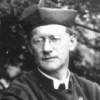
John Sebastian Marlow Ward (22 December 1885 – 1949) was an English author who published widely on the subject of Freemasonry and esotericism.
He was born in what is now Belize. In 1908 he graduated from the University of Cambridge with honours in history, following in the footsteps of his father, Herbert Ward who had also studied in history before entering the priesthood in the Anglican Church, as his father had done before him.
John Ward became a prolific and sometimes controversial writer on a wide variety of topics. He made contributions to the history of Freemasonry and other secret societies.
He was also a psychic medium or spiritualist, a prominent churchman and is still seen by some as a mystic and modern-day prophet.
Recent Articles: J.S.M Ward series

Book Review - The EA, FC, MM Handbooks
Essential reading for every Entered Apprentice, Fellowcraft, and Master Mason - these seminal books by J.S.M Ward are what every Mason needs!
more....
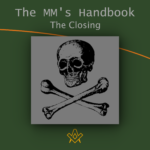 Chapters 9 & 10 The Closing Finally, even if a man can never fathom the full meaning of the third degree, yet there is no man worthy of the name who has passed through that third degree but will certainly have learnt one important lesson, namely, how to die, and thereby will be the better man. |
 Chapter 8 - The Tracing Board - The next part of the narrative is incorporated in most English workings with the Tracing Board. The most interesting feature is the description of the grave. It is obvious that peculiar stress is laid on the centre, even in the present form of our ritual, because of the way in which the measurements are given. |
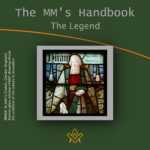 The Master Mason's Handbook P7 Chapter 7 - The Legend - After the ceremonial investiture of the Candidate the W.M. continues the narrative of the traditional history. At least this is the case in most English workings, but in some Scotch workings the whole story is told first, and subsequently the Candidate and the other brethren act the chief parts. Perhaps one of the most important points to realise is the correct meaning of the name Hiram Abiff . |
 The Master Mason's Handbook P6 Chapter 6 - The Badge - On his re-entering the Lodge, the candidate is presented and in due course invested with the badge of a Master Mason by the S.W. The Badge itself, however, is full of symbolic meaning…. |
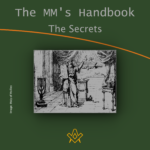 The Master Mason's Handbook P5 Chapter 5 - The Secrets. Having thus been brought into the place of light the Candidate is given not the genuine secrets, but only substituted ones. This fact must often have puzzled the Candidate. The practical reason given in the ritual, though perfectly intelligible to a Royal Arch mason (Companion) , cannot be the real one. |
 The Master Mason's Handbook P4 Chapter 4 - The Exhortation The opening part of the exhortation gives a convenient summary of the previous degrees and quite clearly indicates that the first inner meaning of the series is Birth, Life which is of course educational and preparatory for its sequel, and Death. |
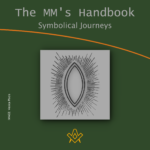 The Master Mason's Handbook P3 Chapter 3 - The Symbolical Journeys; We have seen in the previous books that the square and compasses are united on the pedestal in such a way as to form the Vesica Piscis, the emblem of the female principle, and the symbol of birth and rebirth. Hence symbolically the Candidate passes through the Vesica Piscis. |
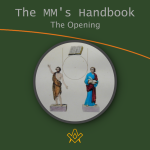 The Master Mason's Handbook P2 Chapter 2 - The Opening; a brief explanation of the teaching of the third degree as contained in the symbols by J.S.M Ward |
 The Master Mason's Handbook P1 Chapter 1 - Questions and Password; a brief explanation of the teaching of the third degree as contained in the symbols by J.S.M Ward |
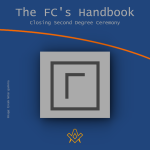 Chapter 6 - Closing Second Degree Ceremony; a brief explanation of the teaching of the second degree as contained in the symbols in the closing part of the ceremony by J.S.M Ward |
 Chapter 5 - The Second Degree Tracing Board; a brief explanation of the teaching of the second degree as contained in the picture of the tracing board according to the ancient mysteries by J.S.M Ward |
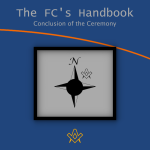 Chapter 4 - Conclusion of the Ceremony; a brief explanation of the North East Corner and the Charge according to the ancient mysteries by J.S.M Ward |
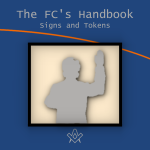 Chapter 3 - The signs and tokens; an explanation of the signs and tokens symbolism of the fellowcraft according to the ancient mysteries by J.S.M Ward |
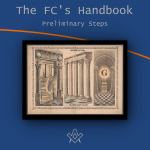 Chapter 2 - Preliminary Steps an explanation of the perambulation and advancement to the east by the winding staircase by J.S.M Ward |
 Chapter 1 - Preparation, past word and opening ceremony - The questions which are put to the candidate are really a test of the lectures, which today, unfortunately, are hardly ever given in open Lodge. |
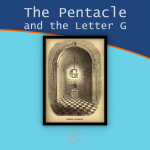 In the centre of the ceiling in every well-decorated Lodge room there should be a pentacle having within it the letter 'G'. |
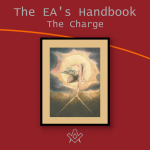 The Entered Apprentices Handbook P7 Chapter 7 - The candidate receives the charge, the first significant point is the phrase "Ancient, no doubt it is, as having subsisted from time immemorial". |
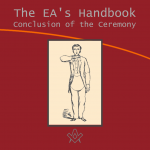 The Entered Apprentices Handbook P6 Chapter 6 - Having taken the first regular step the Candidate is given the Sign. This he is told refers to the Penalty of his Obligation, and no doubt it does, but it also seems to refer to something much more startling. |
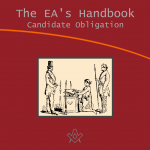 The Entered Apprentices Handbook P5 Chapter 5 - In all the ancient mysteries a candidate obligation was exacted to secure the secret teachings given in these mysteries which disclosed an inner meaning. |
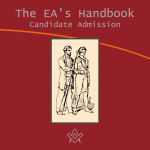 The Entered Apprentices Handbook P4 Chapter 4 - The candidate's admission into the lodge, is received on a sharp instrument. This signifies many things, one idea lying within the other. |
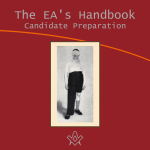 The Entered Apprentices Handbook P3 Chapter 3 - the Candidate being prepared by the Tyler. What we now have is a system by which the parts which have to be bare are made bare. |
 The Entered Apprentices Handbook P2 Chapter 2 - The Tyler or Outer Guard. The first thing that greets the eyes of the aspirant to our Order standing in front of the door with a drawn sword in his hand. |
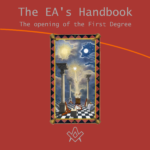 The Entered Apprentices Handbook P1 Chapter 1 - An interpretation of the first degree, the meaning of the preparation, symbolism, ritual and signs. Chapter 1, The opening of the First Degree |
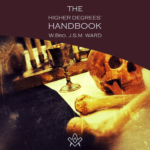 Brief historical overview; Extract from The Higher Degrees ' Handbook by JSM Ward |
masonic knowledge
to be a better citizen of the world
share the square with two brothers

click image to open email app on mobile device








